Performance Assessment of Direct Vapor Generation Solar Organic Rankine Cycle System Coupled with Heat Storage
Abstract
:1. Introduction
2. The Overall System Layout
3. Modeling Based on Thermodynamics
3.1. Solar Radiation
3.2. Thermal Solar Collectors
3.3. Thermal Storage Tank
- Conductive heat transmission is regarded as the PCM’s predominant mechanism;
- One-dimensional heat transmission is considered;
- During each condition, the thermophysical parameters of the PCM stay constant;
- Natural convections may occur owing to density differences, which were disregarded by this model.
3.4. PCM Model Validation
3.5. Organic Rankine Cycle
3.6. A Suitable Organic Fluid for the DVG Solar ORC System
4. Results and Discussions
4.1. During the Warmest Week, PCM-Based DVG Solar ORC System’s Dynamic Performance
4.1.1. Changes in the Temperature of PCMs and the Amount of Solar Radiation over Time
4.1.2. Collector and ORC Efficiencies Variation over Time
4.2. Performanceof the System over the Month
4.2.1. Variation in Collector and ORC Efficiency on Annual Basis
4.2.2. Variation in System Efficiency on Annual Basis
4.2.3. Variation in Net Power Output on Yearly Basis
4.2.4. Variation Energy Stored on Annual Basis
5. Conclusions
Author Contributions
Funding
Institutional Review Board Statement
Informed Consent Statement
Data Availability Statement
Conflicts of Interest
Nomenclature
| Symbols | |
| Work done by expander, W | |
| Work done by pump, W | |
| Enthalpy at expander inlet, kJ/kg | |
| Enthalpy at expander outlet, kJ/kg | |
| Enthalpy of expander at ideal thermodynamic process, kJ/kg | |
| Working fluid mass flow rate, kg/s | |
| Efficiency of expander, % | |
| Efficiency of pump, % | |
| Efficiency of organic Rankine cycle, % | |
| A | area, m2 |
| G | irradiation, W/m2 |
| T | Temperature of collector, °C |
| Tc | Critical temperature, °C |
| Ta | Ambient temperature, °C |
| Temperature of fluid at collector outlet, °C | |
| Temperature of fluid at collector inlet, °C | |
| Surface area of collector in liquid phase, m2 | |
| Surface area of collector in binary phase, m2 | |
| Efficiency of collector in liquid phase, % | |
| Efficiency of collector in binary phase, % | |
| Enthalpy at liquid phase outlet, kJ/kg | |
| Enthalpy at liquid phase inlet, kJ/kg | |
| Enthalpy at binary phase outlet, kJ/kg | |
| Enthalpy at binary phase inlet, kJ/kg | |
| Working fluid mass flow rate, kg/s | |
| Efficiency of collector system, % | |
| Maximum Efficiency, % | |
| System thermal efficiency, % | |
| Latent heat of the PCM, (J) | |
| Abbreviations | |
| GWP | Global Warming Potential |
| ODP | Ozone Depletion Potential |
| ORC | Organic Rankine Cycle |
| DVG | Direct vapor generation |
| FPC | Flat plate collector |
| CPC | Compound parabolic concentrator |
| ETC | Evacuated tube collector |
| PTC | Parabolic trough concentrator |
| CHP | Combined heat and power |
| HTF | Heat transfer fluid |
| DSG | direct steam generation |
| CSP | Concentrated solar power |
| PCM | Phase change material |
| G | Generator |
| P | Pump |
| Subscript | |
| ORC | Organic Rankine Cycle |
| Opt | Optimum |
| max | maximum |
| Sys | System |
| c | critical |
| i | inlet |
| o | outlet |
| 0 | Reference state |
| m | Melting point |
| evp | evaporation |
References
- Peng, S.; Hong, H.; Jin, H.; Wang, Z. An integrated solar thermal power system using intercooled gas turbine and Kalina cycle. Energy 2012, 44, 732–740. [Google Scholar] [CrossRef]
- Iqbal, M.A.; Rana, S.; Ahmadi, M.; Date, A.; Akbarzadeh, A. Experimental study on the prospect of low-temperature heat to power generation using Trilateral Flash Cycle (TFC). Appl. Therm. Eng. 2020, 172, 115139. [Google Scholar] [CrossRef]
- Chen, H.; Goswami, D.Y.; Stefanakos, E.K. A review of thermodynamic cycles and working fluids for the conversion of low-grade heat, Renew. Sustain. Energy Rev. 2010, 14, 3059–3067. [Google Scholar] [CrossRef]
- Imran, M.; Haglind, F.; Asim, M.; Alvi, J.Z. Recent research trends in organic Rankine cycle technology: A bibliometric approach, Renew. Sustain. Energy Rev. 2018, 81, 552–562. [Google Scholar] [CrossRef] [Green Version]
- Papadopoulos, A.I.; Stijepovic, M.; Linke, P. On the systematic design and selection of optimal working fluids for Organic Rankine Cycles. Appl. Therm. Eng. 2010, 30, 760–769. [Google Scholar] [CrossRef]
- Soliman, A.M.; Alharbi, A.G.; Eldean, M.A.S. Techno-economic optimization of a solar-wind hybrid system to power a large-scale reverse osmosis desalination plant. Sustainability 2021, 13, 11508. [Google Scholar] [CrossRef]
- Usman, M.; Imran, M.; Yang, Y.; Lee, D.H.; Park, B.-S. Thermo-Economic comparison of air-cooled and cooling tower based Organic Rankine cycle (ORC) with r245fa and r1233zde as candidate working fluids for different geographical climate conditions. Energy 2017, 123, 353–366. [Google Scholar] [CrossRef]
- Alvi, J.Z.; Imran, M.; Pei, G.; Li, J.; Gao, G.; Alvi, J. Thermodynamic comparison and dynamic simulation of direct and indirect solar organic Rankine cycle systems with PCM storage. Energy Procedia 2017, 129, 716–723. [Google Scholar] [CrossRef]
- Mahmoudi, S.M.S.; Sarabchi, N.; Yari, M.; Rosen, M.A. Exergy and exergoeconomic analyses of a combined power producing system including a proton exchange membrane fuel cell and an organic rankine cycle. Sustainability 2019, 44, 3264. [Google Scholar] [CrossRef] [Green Version]
- Xu, G.; Song, G.; Zhu, X.; Gao, W.; Li, H.; Quan, Y. Performance evaluation of a direct vapor generation supercritical ORC system driven by linear Fresnel reflector solar concentrator. Appl. Therm. Eng. 2015, 80, 196–204. [Google Scholar] [CrossRef]
- Wang, X.D.; Zhao, L.; Wang, J.L. Experimental investigation on the low-temperature solar Rankine cycle system using R245fa. Energy Convers. Manag. 2011, 52, 946–952. [Google Scholar] [CrossRef]
- Wang, J.L.; Zhao, L.; Wang, X.D. An experimental study on the recuperative low temperature solar Rankine cycle using R245fa. Appl. Energy. 2012, 94, 34–40. [Google Scholar] [CrossRef]
- Alvi, J.Z.; Feng, Y.; Wang, Q.; Imran, M.; Pei, G. Effect of working fluids on the performance of phase change material storage based direct vapor generation solar organic Rankine cycle system. Energy Rep. 2021, 7, 348–361. [Google Scholar] [CrossRef]
- Bu, X.B.; Li, H.S.; Wang, L.B. Performance analysis and working fluids selection of solar powered organic Rankine-vapor compression ice maker. Sol. Energy. 2013, 95, 271–278. [Google Scholar] [CrossRef]
- Wang, X.D.; Zhao, L.; Wang, J.L.; Zhang, W.Z.; Zhao, X.Z.; Wu, W. Performance evaluation of a low-temperature solar Rankine cycle system utilizing R245fa. Sol. Energy 2010, 84, 353–364. [Google Scholar] [CrossRef]
- Asim, M.; Kashif, F.; Umer, J.; Alvi, J.Z.; Imran, M.; Khan, S.; Zia, A.W.; Leung, M.K.H. Performanceassessment and working fluid selection for novel integrated vapor compression cycle and organic rankine cycle for ultra low grade waste heat recovery. Sustainability 2021, 13, 11592. [Google Scholar] [CrossRef]
- Osintsev, K.; Aliukov, S. ORC Technology Based on Advanced Li-Br Absorption Refrigerator with Solar Collectors and a Contact Heat Exchanger for Greenhouse Gas Capture. Sustainability 2022, 14, 5520. [Google Scholar] [CrossRef]
- Gang, P.; Jing, L.; Jie, J. Design and analysis of a novel low-temperature solar thermal electric system with two-stage collectors and heat storage units. Renew. Energy 2011, 36, 2324–2333. [Google Scholar] [CrossRef]
- Freeman, J.; Guarracino, I.; Kalogirou, S.A.; Markides, C.N. A small-scale solar organic Rankine cycle combined heat and power system with integrated thermal energy storage. Appl. Therm. Eng. 2017, 127, 1543–1554. [Google Scholar] [CrossRef]
- Manfrida, G.; Secchi, R.; Stańczyk, K. Modelling and simulation of phase change material latent heat storages applied to a solar-powered Organic Rankine Cycle. Appl. Energy 2016, 179, 378–388. [Google Scholar] [CrossRef]
- Tian, Y.; Zhao, C.Y. A review of solar collectors and thermal energy storage in solar thermal applications. Appl. Energy 2013, 104, 538–553. [Google Scholar] [CrossRef] [Green Version]
- Calise, F.; D’Accadia, M.D.; Vicidomini, M.; Scarpellino, M. Design and simulation of a prototype of a small-scale solar CHP system based on evacuated flat-plate solar collectors and Organic Rankine Cycle. Energy Convers. Manag. 2015, 90, 347–363. [Google Scholar] [CrossRef]
- Cinocca, A.; di Bartolomeo, M.; Cipollone, R.; Carapellucci, R. A Definitive Model of a Small-Scale Concentrated Solar Power Hybrid Plant Using Air as Heat Transfer Fluid with a Thermal Storage Section and ORC Plants for Energy Recovery. Energies 2020, 13, 4741. [Google Scholar] [CrossRef]
- Da Cunha, J.P.; Eames, P. Thermal energy storage for low and medium temperature applications using phase change materials—A review. Appl. Energy 2016, 177, 227–238. [Google Scholar] [CrossRef] [Green Version]
- Agyenim, F.; Hewitt, N.; Eames, P.; Smyth, M. A review of materials, heat transfer and phase change problem formulation for latent heat thermal energy storage systems (LHTESS). Renew. Sustain. Energy Rev. 2010, 14, 615–628. [Google Scholar] [CrossRef]
- Hasnain, S.M. Review on sustainable thermal energy storage technologies, Part I: Heat storage materials and techniques. Energy Convers. Manag. 1998, 39, 1127–1138. [Google Scholar] [CrossRef]
- Lizana, J.; Bordin, C.; Rajabloo, T. Integration of solar latent heat storage towards optimal small-scale combined heat and power generation by Organic Rankine Cycle. J. Energy Storage 2020, 29, 101367. [Google Scholar] [CrossRef]
- Abbasi, H.R.; Pourrahmani, H.; Yavarinasab, A.; Emadi, M.A.; Hoorfar, M. Exergoeconomic optimization of a solar driven system with reverse osmosis desalination unit and phase change material thermal energy storages. Energy Convers. Manag. 2019, 199, 112042. [Google Scholar] [CrossRef]
- Waqas, A.; Ji, J. Thermal management of conventional PV panel using PCM with movable shutters—A numerical study. Sol. Energy 2017, 158, 797–807. [Google Scholar] [CrossRef]
- Lakhani, S.; Raul, A.; Saha, S.K. Dynamic modelling of ORC-based solar thermal power plant integrated with multitube shell and tube latent heat thermal storage system. Appl. Therm. Eng. 2017, 123, 458–470. [Google Scholar] [CrossRef]
- Abbasi, H.R.; Pourrahmani, H. Multi-objective optimization and exergoeconomic analysis of a continuous solar-driven system with PCM for power, cooling and freshwater production. Energy Convers. Manag. 2020, 211, 112761. [Google Scholar] [CrossRef]
- Hoffmann, J.F.; Fasquelle, T.; Goetz, V.; Py, X. A thermocline thermal energy storage system with filler materials for concentrated solar power plants: Experimental data and numerical model sensitivity to different experimental tank scales. Appl. Therm. Eng. 2016, 100, 753–761. [Google Scholar] [CrossRef]
- Costa, S.-C.; Mahkamov, K.; Kenisarin, M.; Lynn, K.; Halimic, E.; Mullen, D. Solar Salt Latent Heat Thermal Storage for a Small Solar Organic Rankine Cycle Plant. In Proceedings of the ASME 2018 12th International Conference on Energy Sustainability collocated with the ASME 2018 Power Conference and the ASME 2018 Nuclear Forum, Lake Buena Vista, FL, USA, 24–28 June 2018. [Google Scholar]
- Costa, S.-C.; Mahkamov, K.; Kenisarin, M.; Ismail, M.; Lynn, K.; Halimic, E.; Mullen, D. Solar Salt Latent Heat Thermal Storage for a Small Solar Organic Rankine Cycle Plant. J. Energy Resour. Technol. 2020, 142, 31203. [Google Scholar] [CrossRef] [Green Version]
- Alvi, J.Z.; Feng, Y.; Wang, Q.; Imran, M. Modelling, simulation and comparison of phase change material storage. Appl. Therm. Eng. 2019, 170, 114780. [Google Scholar] [CrossRef]
- Meteonorm. Global Solar Radiation Database—METEONORM. 2015. Available online: https://meteonorm.com/en/typical-meteorological-years (accessed on 8 November 2022).
- Voller, V.R.; Cross, M.; Markatos, N.C. An enthalpy method for convection/diffusion phase change. Int. J. Numer. Methods Eng. 1987, 24, 271–284. [Google Scholar] [CrossRef]
- Günther, E.; Hiebler, S.; Mehling, H. Redlich, Enthalpy of Phase Change Materials as a Function of Temperature: Required Accuracy and Suitable Measurement Methods. Int. J. Thermophys. 2009, 30, 1257–1269. [Google Scholar] [CrossRef]
- Kuravi, S.; Trahan, J.; Goswami, D.Y.; Rahman, M.M.; Stefanakos, E.K. Thermal energy storage technologies and systems for concentrating solar power plants. Prog. Energy Combust. Sci. 2013, 39, 285–319. [Google Scholar] [CrossRef]
- Iasiello, M.; Braimakis, K.; Andreozzi, A.; Karellas, S. Thermal analysis of a Phase Change Material for a Solar Organic Rankine Cycle. J. Phys. Conf. Ser. 2017, 923, 12042. [Google Scholar] [CrossRef] [Green Version]
- Lacroix, M. Numerical simulation of a shell-and-tube latent heat thermal energy storage unit. Sol. Energy 1993, 50, 357–367. [Google Scholar] [CrossRef]
- Li, J.; Li, P.; Pei, G.; Alvi, J.Z.; Ji, J. Analysis of a novel solar electricity generation system using cascade Rankine cycle and steam screw expander. Appl. Energy 2016, 165, 627–638. [Google Scholar] [CrossRef]

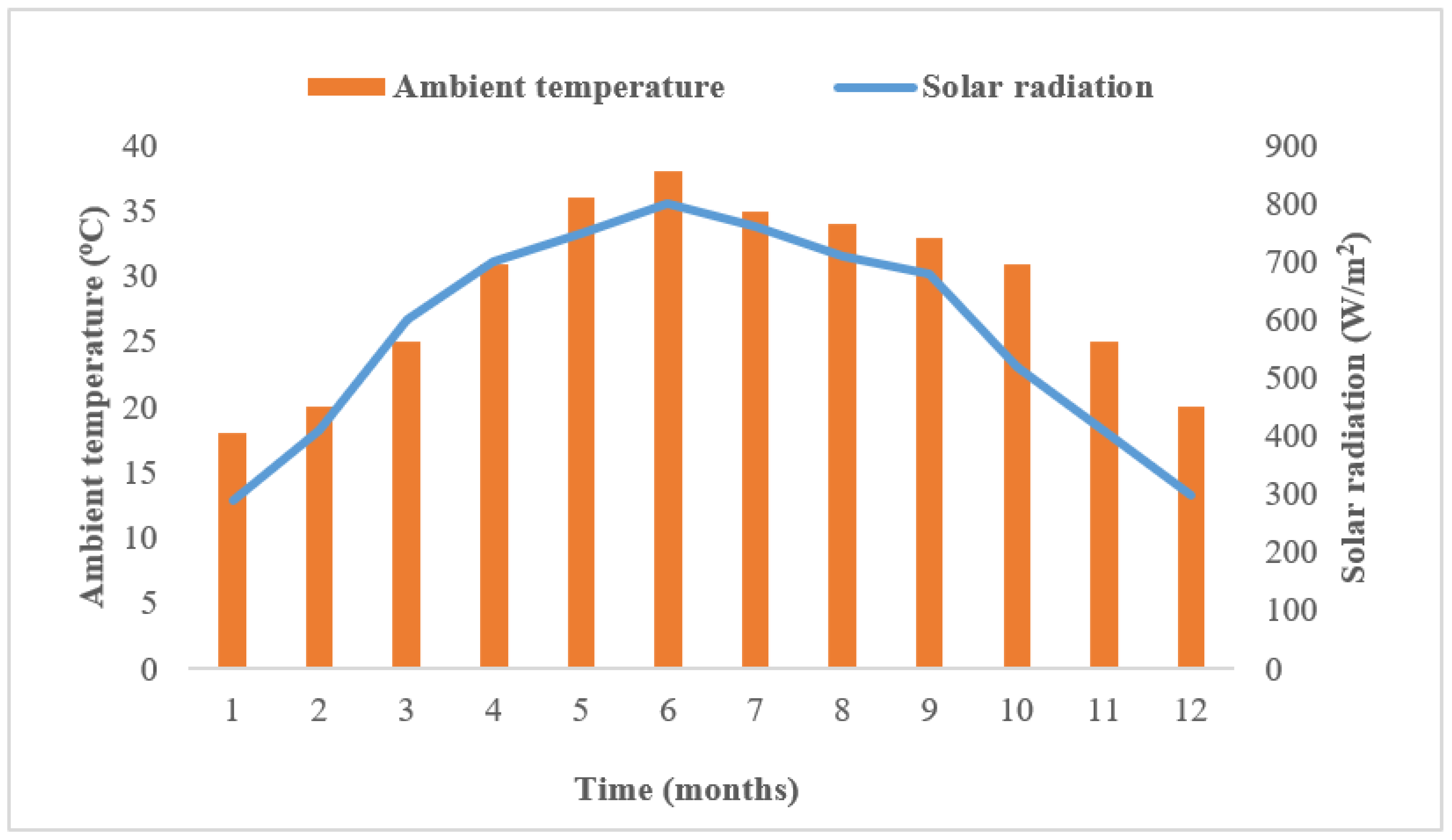

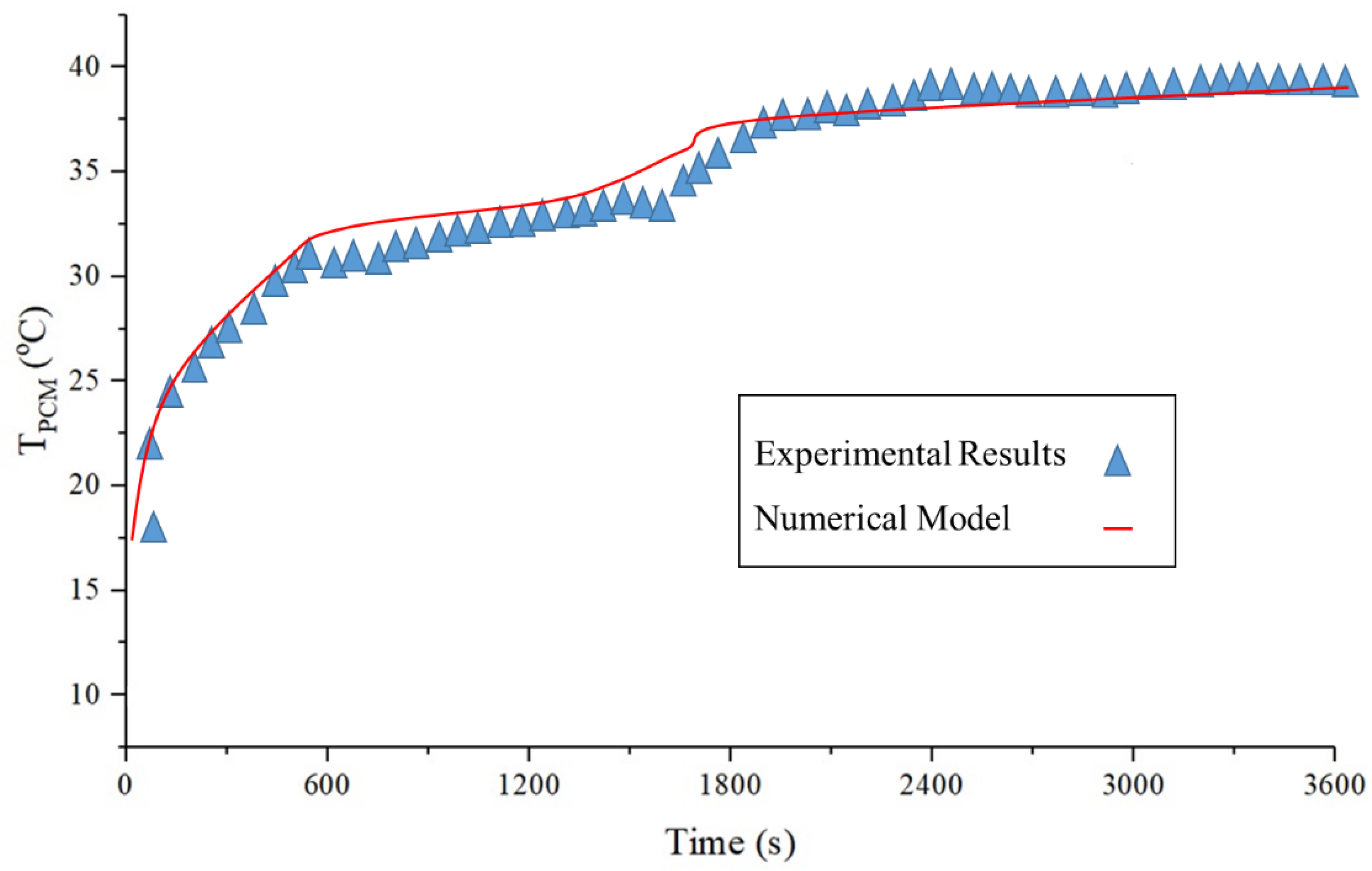
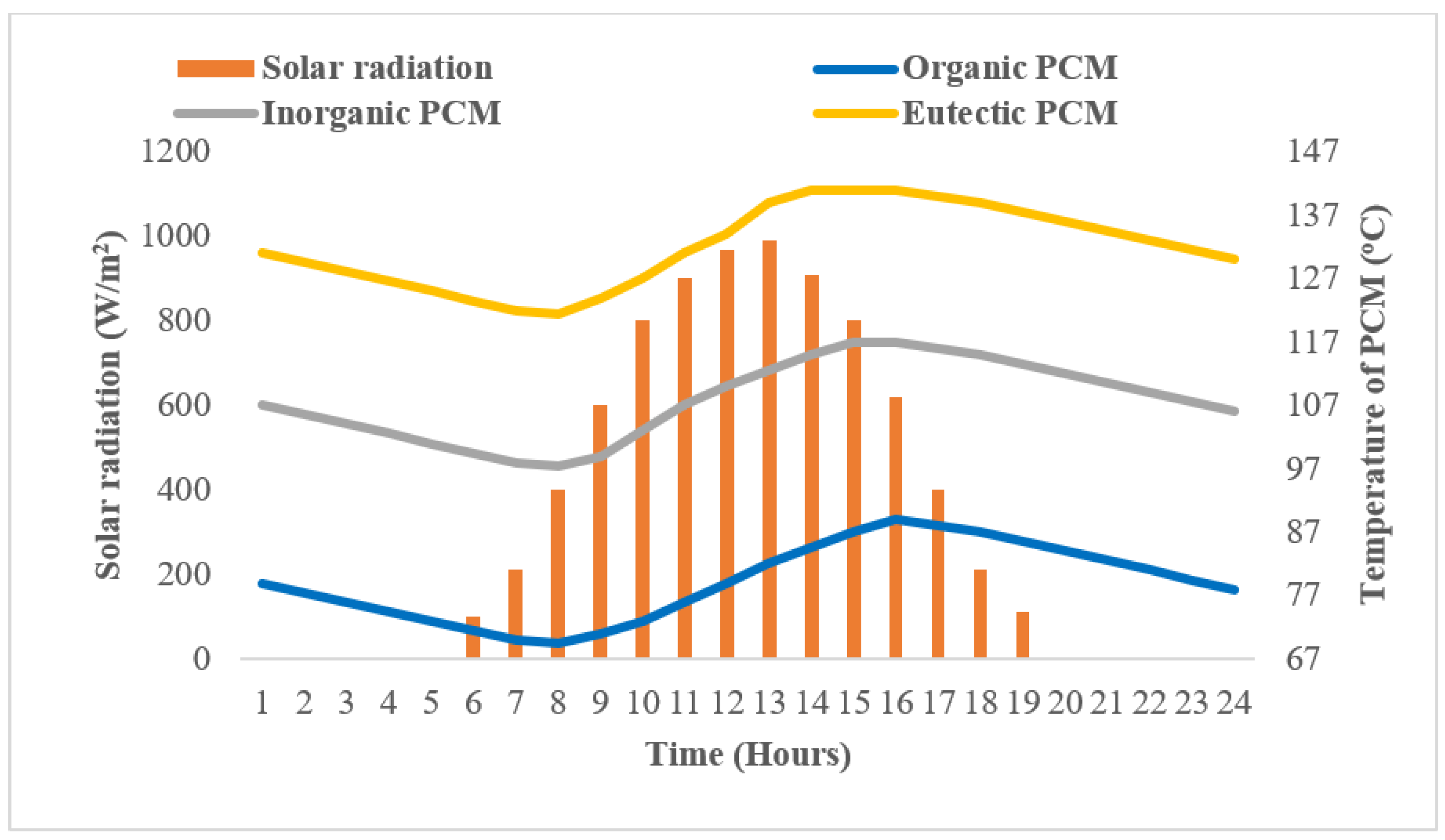
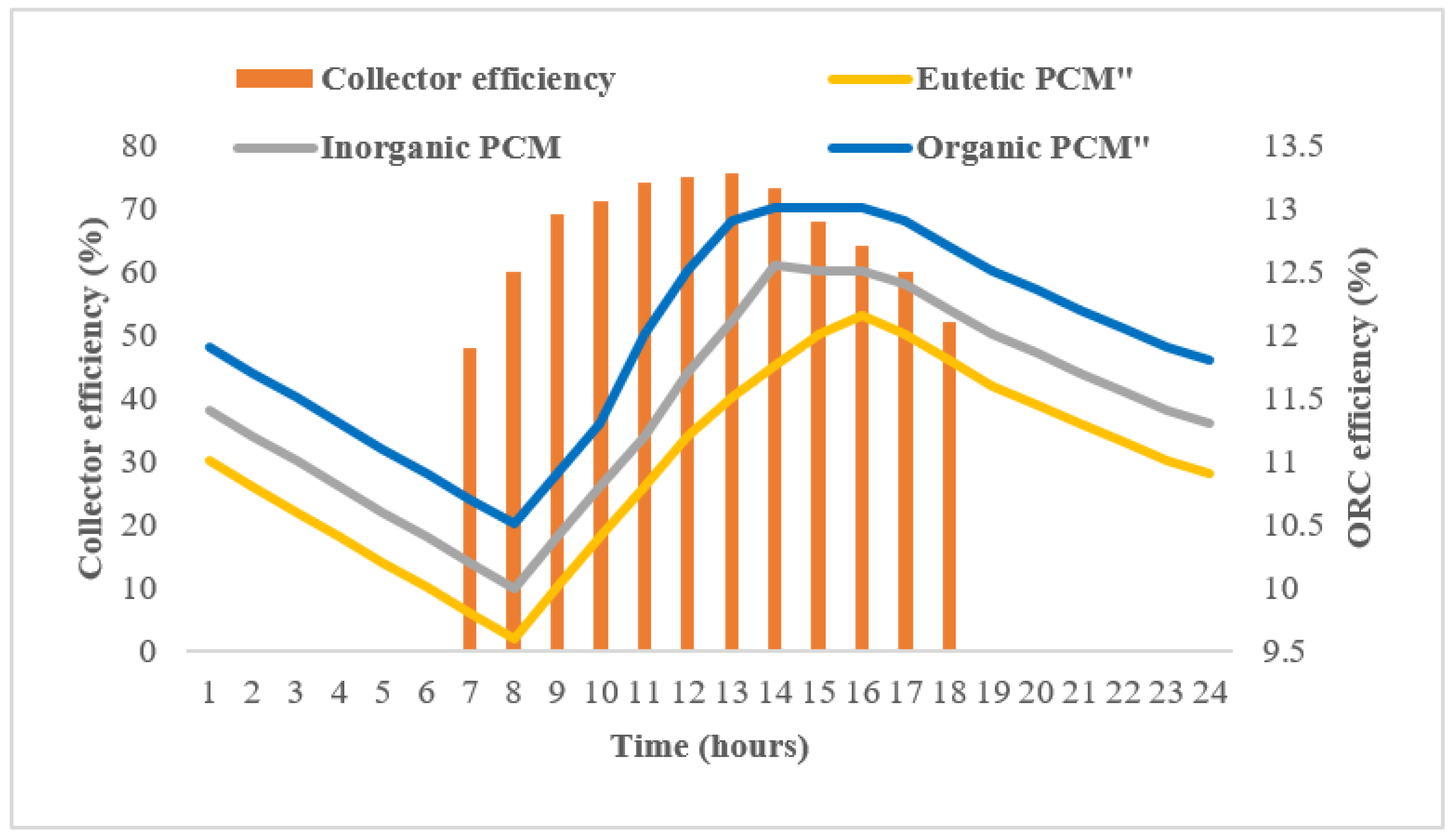

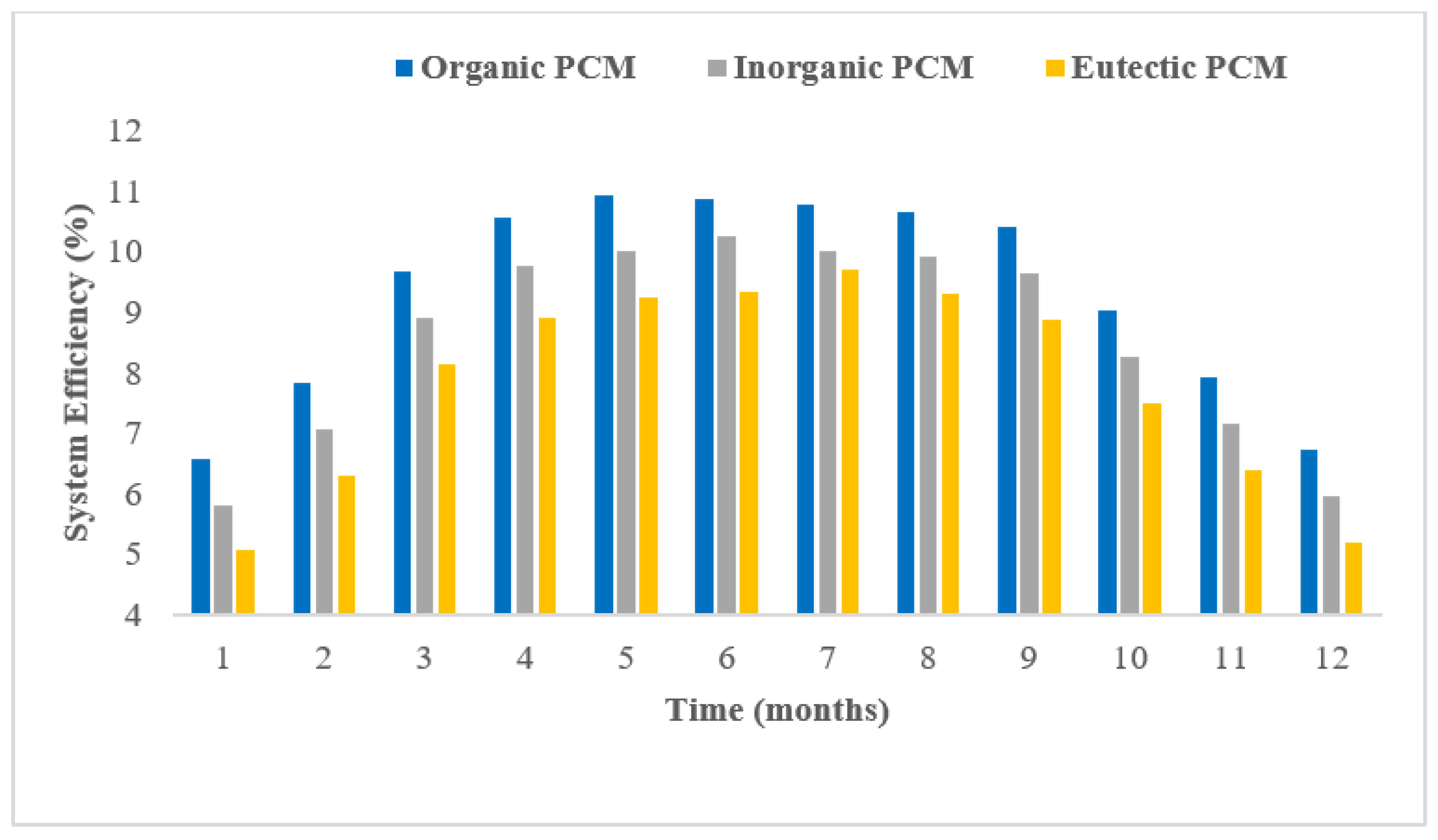
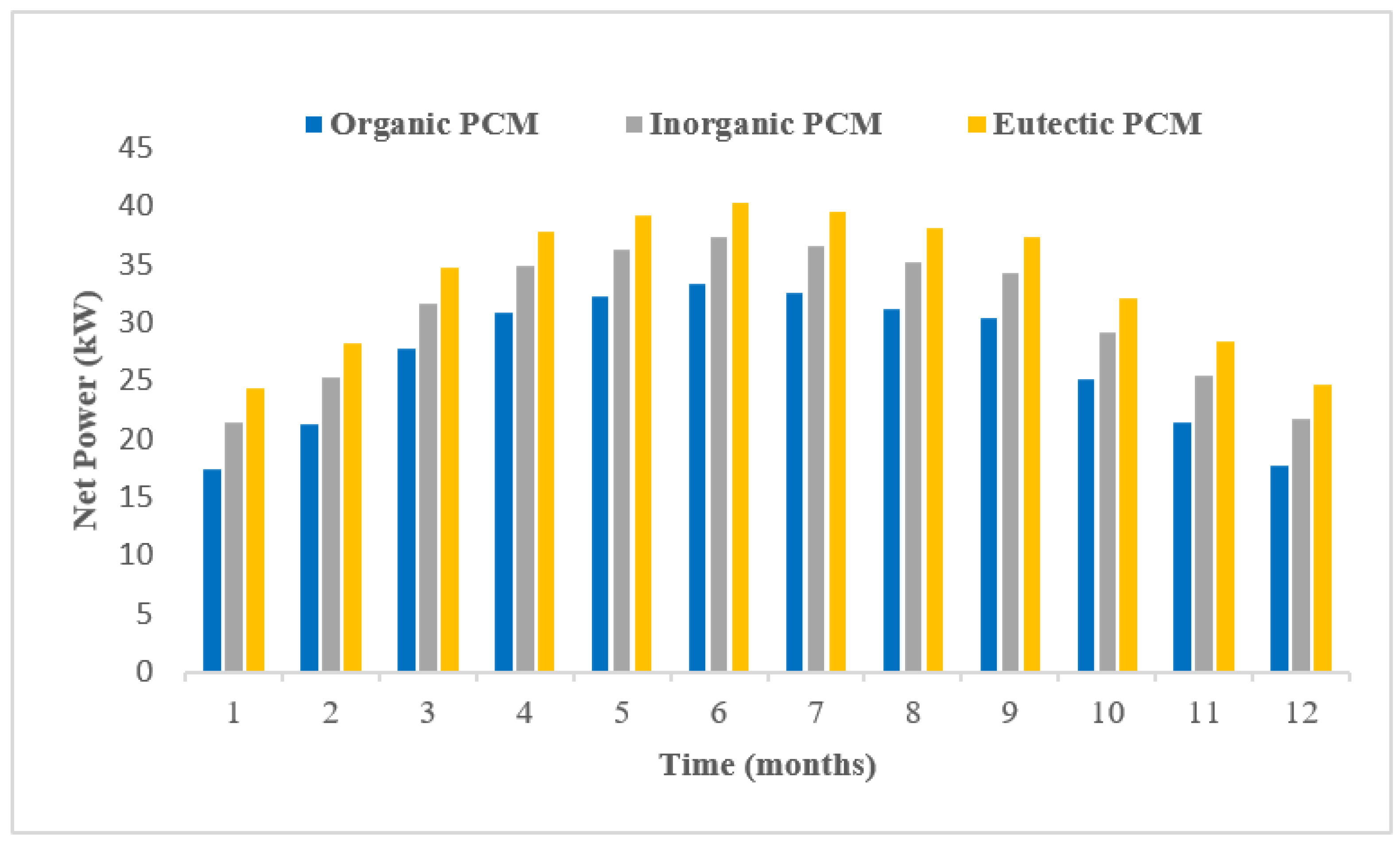
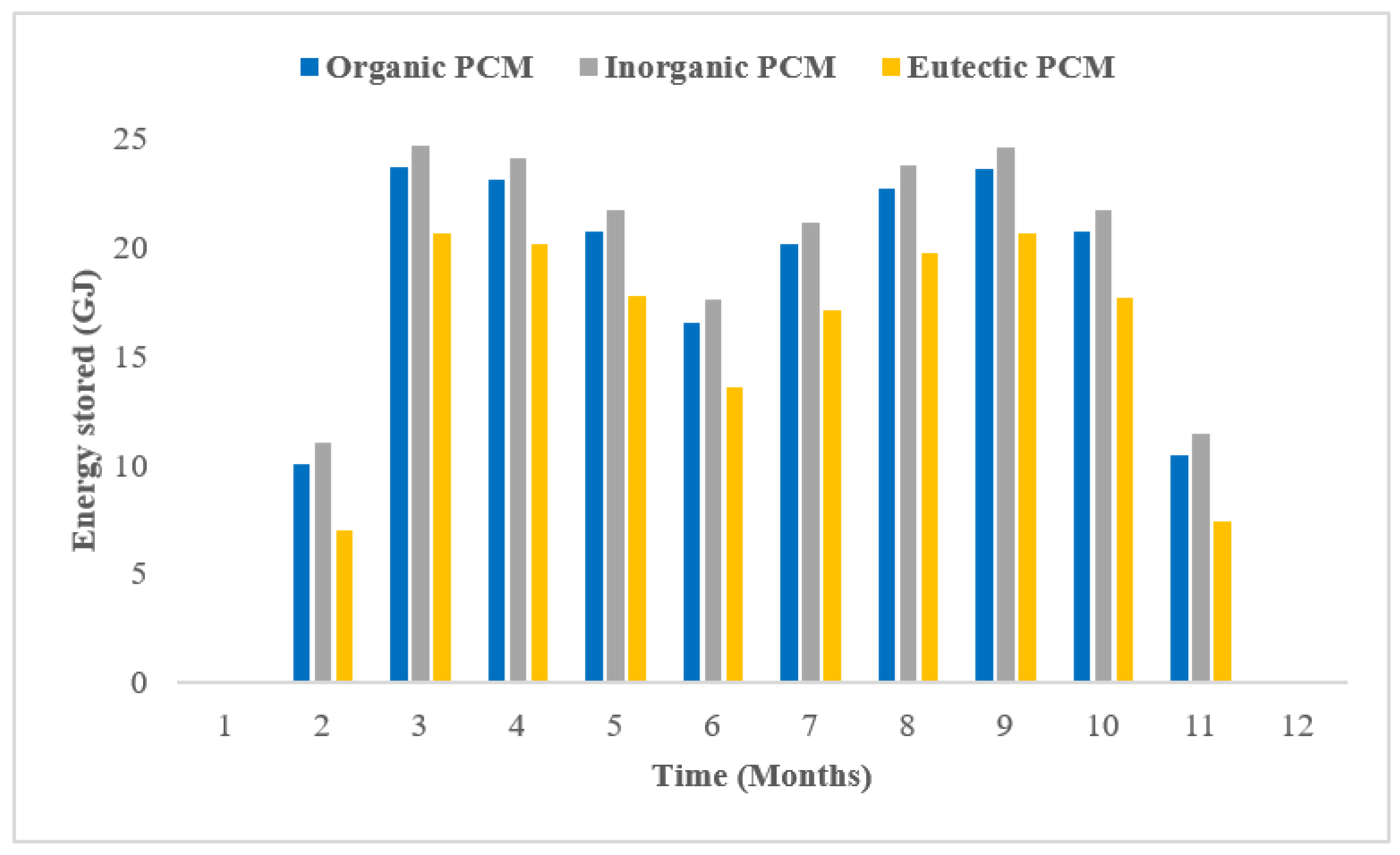
| Name of the PCM | MgCl2.6H20 | Mg(NO3)2.6H2O | KNO3-NaNO2 | |
|---|---|---|---|---|
| PCM category | Inorganic | Organic | Eutectic | |
| Melting point temperature (°C) | 116.7 | 89 | 141 | |
| Latent heat (kJ/kg) | 160 | 140 | 97 | |
| Thermal conductivity (W/m2-°C) | both states (solid & liquid) | 0.7 | 0.58 | 0.65 |
| Specific heat capacity (kJ/kg-°C) | both states (solid & liquid) | 2.61 | 2.78 | 1.46 |
| Thermophysical Property | Value | |
|---|---|---|
| Melting point temperature (°C) | 28.2 | |
| Latent heat (kJ/kg) | 243.5 | |
| Density (kg/m3) | Solid | 861 |
| Liquid | 772 | |
| Thermal conductivity (W/m2-°C) | Solid | 0.358 |
| Liquid | 0.148 | |
| Specific heat capacity (kJ/kg-°C) | Solid | 1.85 |
| Liquid | 2.33 | |
Publisher’s Note: MDPI stays neutral with regard to jurisdictional claims in published maps and institutional affiliations. |
© 2022 by the authors. Licensee MDPI, Basel, Switzerland. This article is an open access article distributed under the terms and conditions of the Creative Commons Attribution (CC BY) license (https://creativecommons.org/licenses/by/4.0/).
Share and Cite
Alvi, J.Z.; Jinghu, Y.; Feng, Y.; Asim, M.; Qian, W.; Pei, G. Performance Assessment of Direct Vapor Generation Solar Organic Rankine Cycle System Coupled with Heat Storage. Sustainability 2022, 14, 15296. https://doi.org/10.3390/su142215296
Alvi JZ, Jinghu Y, Feng Y, Asim M, Qian W, Pei G. Performance Assessment of Direct Vapor Generation Solar Organic Rankine Cycle System Coupled with Heat Storage. Sustainability. 2022; 14(22):15296. https://doi.org/10.3390/su142215296
Chicago/Turabian StyleAlvi, Jahan Zeb, Yu Jinghu, Yongqiang Feng, Muhammad Asim, Wang Qian, and Gang Pei. 2022. "Performance Assessment of Direct Vapor Generation Solar Organic Rankine Cycle System Coupled with Heat Storage" Sustainability 14, no. 22: 15296. https://doi.org/10.3390/su142215296







